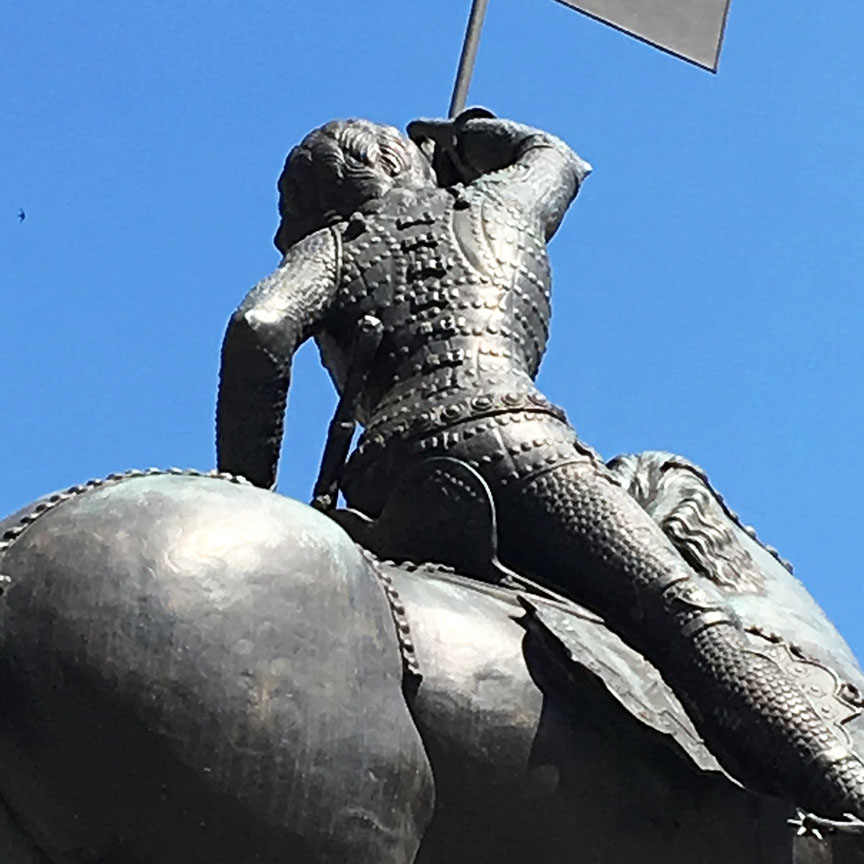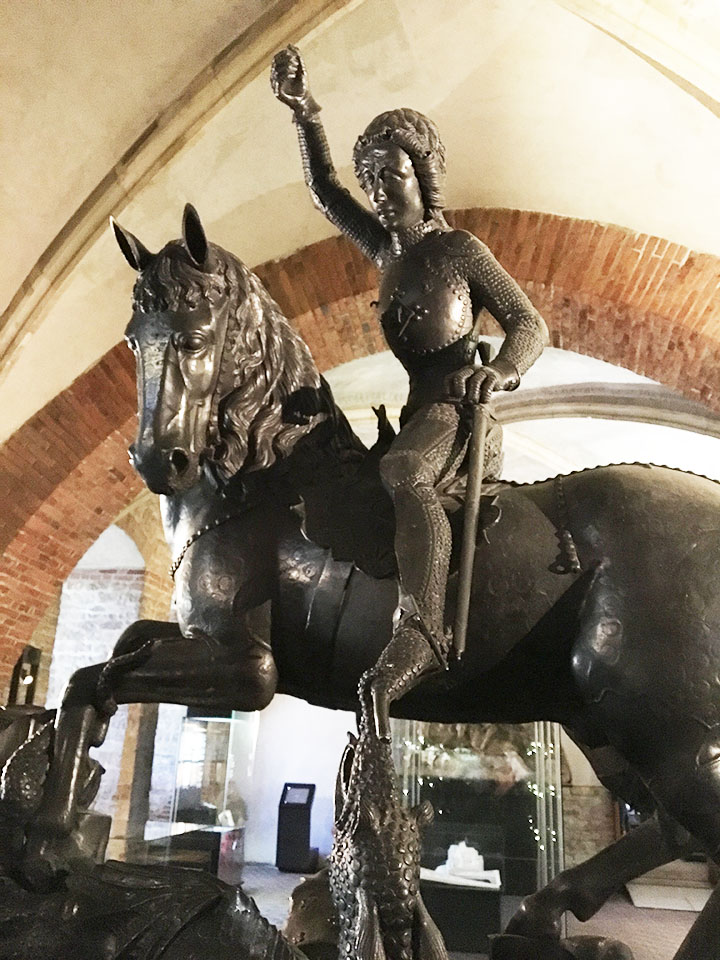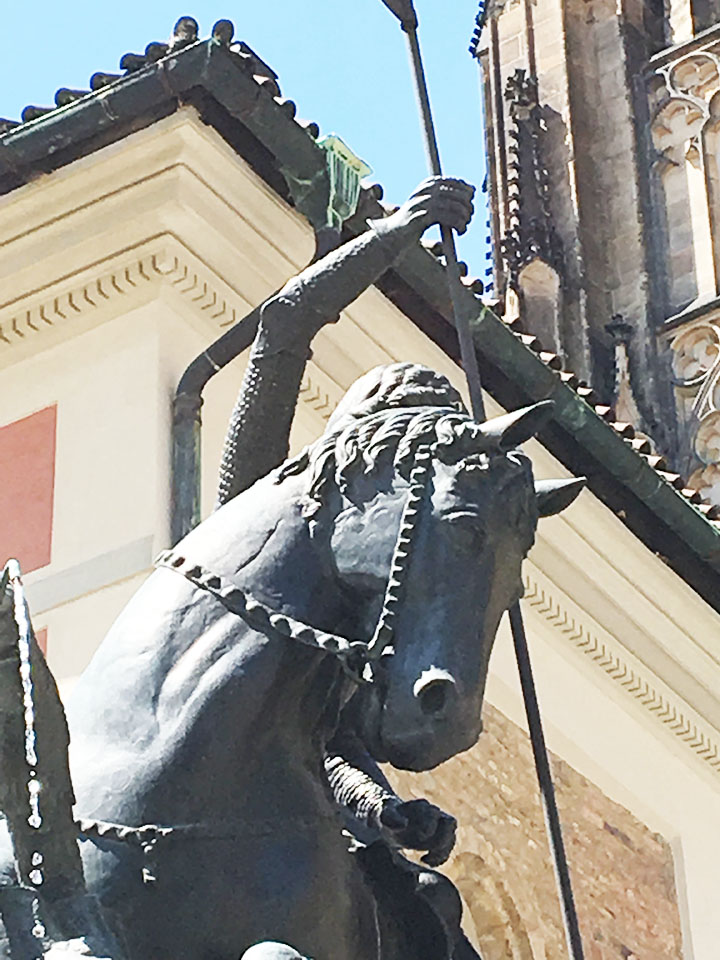Fair warning, this post is for all my armour peeps out there. Also, please do not download and repost my photos without linking back to this blog post and attributing my name as the photographer.
Right in the middle of the Prague Castle complex sits a faithful reproduction of a statue of St. George and the Dragon. The original dates to 1373 and languishes in somewhat dim lighting inside the “Story of Prague” exhibit. Our friend Bob Charrette of La Belle Compagnie requested that we photograph it as best we could, and so I did, even taking some photos of the original version in dim lighting, though the exhibit does not allow photography.
These photos are a mixed bag—when the sun was at my back, the photos came out well enough, but when the sun was in front of me, predictable trouble ensued. I’ve tried to lighten them up as much as possible to pick out detail. I was further hampered by the fact that these are iPhone pictures. I chose not to bring my good camera on this trip due to its bulk. I didn’t want to cross the line where I’m only documenting historical stuff and no longer really on vacation with my sweetheart.
Fortunately, we arrived in the courtyard containing St. George at the perfect time to photograph the back of the statue, an aspect that is under-represented in images found in your typical Google search. But first, some background information:

Have you wondered exactly how many buckles close the back of George’s corazzina? The answer could range from 9 to 10, depending on whether or not you believe there’s a buckle under the knightly belt around his hips. There is also another buckle at the bottom, obscured by the saddle. This was confirmed for me by Bertus Brokamp, who has seen another casting of this statue in the Victoria and Albert Museum in London, where it is low enough to see.


I love that this statue shows us that medieval men at arms did not sit in their saddles like we sit in chairs. They didn’t bend their knees a lot, except as necessary to twist around. They held their legs straight and braced for the most part. This position gave them the most collected body mechanics possible for the fast and brutal application of upper body strength.




Another noteworthy feature of our George is that he’s wearing nicely tailored mail from his neck down to his toes. His greaves are particularly shapely, as are the pointy-toed soles supporting his feet. Note, the mail appears as simple, overlapping, circular discs, no indents in the middle of each disc.



Lastly, I offer some skeptical observations. Here’s a photo of George’s long, thin arm, raised to strike down the dragon. Note his elbow cop. It’s shallow at best, preventing total coverage of the elbow when the arm is bent. The straps are so wide apart that they are going to bind the arm should it bend any more than it is already. I have to wonder if this is artistic license rather than a faithful representation of an actual elbow cop’s strapping. The bell on his gauntlet is narrow, even in comparison to surviving examples, like the Black Prince’s. There’s not a lot of wrist range before the flesh is fighting the metal.

In conclusion, the cast bronze statue of St. George and the Dragon in Prague portrays an idealized example of transitional armour in later 14th century central Europe. It’s a treasure for armour historians, not least of which because it provides copious material for critical analysis.

5 thoughts on “St. George in Prague—His Corazzina and Other Armour Details”
I suspect that you are correct, in that there may be a lot of Artistic License in the depiction of the armour.
Great post, Gretta. The armor Jeff Wasson made for me was based on this example. See http://wassonartistry.com/armor.php?w=1380senglish
Thomas
Thanks, Tom. I do recall that yours is based on that same statue, similar to the one Mac made for Will too, I think. I’m Tasha though, not Greta. ;^)
Tasha, did you notice, that the elbow cops seem to be made out of three pieces, with the straps linked to the two outer pieces? This might indicate a flexible construction.
Another interesting thing is, that at least in a German Wikipedia article the sculpture is attributed to Georg und Martin of Klausenburg, from Hungaria. (https://de.wikipedia.org/wiki/Georg_und_Martin_von_Klausenburg)
Interesting that in the museum description does not mention this. But maybe there is new evidence…
That’s interesting info, Holger, about the Georg and Martin of Klausenberg — thanks for sharing it. It may very well be unknown to the Prague Castle curators, or it is known, but there isn’t a budget to re-issue the informational plaque. As for the elbow, it didn’t look like 3 pieces to me at the time, but I can see the rivet pattern that might make it appear like 3 pieces after all… hard for me to say. My pictures were inexpert at best.